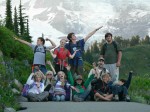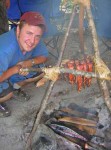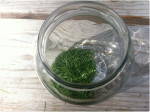 If you would like intensive, hands-on training to become a highly effective outdoor leader, join us in mid June for our annual OUTDOOR LEADERSHIP TRAINING EXPEDITION: Backpacking into Wolf Country course or stay all summer and graduate from one of our six unique residential summer Environmental Education Apprenticeships on Outdoor Leadership & Nature Guiding, on Ethnobotany & Herbalism, on Wildlife Conservation & Tracking, on Traditional Technology & Survival, or on Homesteading & Sustainability.
If you would like intensive, hands-on training to become a highly effective outdoor leader, join us in mid June for our annual OUTDOOR LEADERSHIP TRAINING EXPEDITION: Backpacking into Wolf Country course or stay all summer and graduate from one of our six unique residential summer Environmental Education Apprenticeships on Outdoor Leadership & Nature Guiding, on Ethnobotany & Herbalism, on Wildlife Conservation & Tracking, on Traditional Technology & Survival, or on Homesteading & Sustainability.
Habit of Engaging the Frontal Cortex
Calling all 20 something outdoor leaders! Don’t be like me. Realize that the neural insulation that connects our frontal lobes is not fully knitted until we are in our mid 20’s. I have been fortunate enough to stop and think before anyone under my care over the past 25 years ever got physically hurt. But on a deeper level, there were probably a few people I scared away from nature and outdoor recreation by pushing them through too-risky situations. Upon retrospect, the risks weren’t worth the benefits.
 Just because our frontal lobes – the place where humans assess consequences of our decisions – do not fully form until we are older, does not mean that young people can’t make smart decisions. It’s just that young people have to develop a conscious habit of engaging their frontal lobes, rather than operating out of their brain stems – the place where animals operate out of instinct. Older people have survived to be 25 by developing this habit.
Just because our frontal lobes – the place where humans assess consequences of our decisions – do not fully form until we are older, does not mean that young people can’t make smart decisions. It’s just that young people have to develop a conscious habit of engaging their frontal lobes, rather than operating out of their brain stems – the place where animals operate out of instinct. Older people have survived to be 25 by developing this habit.
But even if you are older and your frontal insulation is fully formed, it can still be challenging to engage your frontal lobes if you are HALT: Hungry, Angry, Lonely, Thirsty; or Hurting, Alienated, Loving, or Tired. Just click on that last link for the science of this truth, and before making any decision of consequence, address any acutely HALT situation. In other words: eat if your blood sugar might be low; drink some water with electrolytes (so your sodium level doesn’t fall too much) if you feel a bit dehydrated.
Why Bother? Perceived vs Actual Risk
What makes risk worthwhile? Why take risks at all? Well, it’s all a matter of priorities. We would never step foot in an automobile – our greatest daily activity risk according to the CDC at 35,000 U.S. deaths in 2011 – or an airplane if it weren’t worth getting somewhere. And in outdoor settings, the benefits of learning something about nature, or achieving a spiritual awakening, or realizing that we are far more capable than we think – these are well worth the risks of being outside.
Note that exposure to toxins – at 33,500 U.S. deaths in 2011 – is our second greatest accidental risk, and if you add inhalation of smoke from fire to that, the number surpasses 36,000. So arguably, exposure to poisonous substances may be our greatest risk even outdoors, especially since it has a low perceived incident rate, but an actual high rate. This concept is critical to understand, as Paul Nicolazzo of the Wilderness Medical Training Center emphasizes in his risk management training courses.
Our next biggest risk outdoors has a high perceived risk rate, and a high actual risk rate: bonks and falls (at 27,000 deaths in city and wilderness in 2011) and it is definitely my biggest paranoia whenever leading groups. In fact, when I was younger, I remember leading groups up slopes and along ridges that I would avoid nowadays, unless securely roped-up. Futhermore, remember that it’s “bonks” and falls, meaning that whenever the wind picks up – get to a safe place. If you have ever been in the forest during a wind storm, you know exactly the kind of danger I’m talking about.
Unless water, or lack thereof, is an issue – then that’s my biggest paranoia when leading. There were 3,500 accidental U.S. drownings in 2011, for instance. Water threatens our biggest survival need – air, and water also threatens our second biggest need – the regulation of our body temperature. In other words, if you are wet, you will chill, and if you are dehydrated, you will not be able to regulate your temperature, and in heat stroke situations, you cannot reverse the problem in the field without cold water submersion and IV hydration.
What To Do? Mitigating Risks of the Eight Great Outdoor Hazards

- Traveling There: You may think nothing of climbing into your car and driving out to a natural area, but this is actually the most dangerous part of your adventure. Include the complications of inclement weather and darkness while driving, and you risk a hazard that is more severe than all the rest put together. Bottom line: to mitigate this hazard, don’t drive in slippery conditions, and always drive the speed limit or lower if you are hauling a load, including full passenger vans.
- Water Hazards & Hypothermia: Water makes you cold faster than anything, and hypothermia is a top concern while in the natural world. Drowning is, of course, another water hazard, and in addition, many unthinking people have dived into shallow water, only to suffer often fatal head and spine injuries. Bottom line: to mitigate this hazard, take open water lifeguard training, and practice regularly with your team. Start by watching youtube videos of actual rescues.
- Dehydration & Hunger: Another big danger involves your consumption – or lack thereof – of water, and next, food. Unfortunately, we need to purify water nowadays if we want to avoid getting giardia and other water-borne diseases. Also, being well-hydrated helps balance your temperature, keeping you warmer in the cold and cooler in the heat, so go ahead and drink that water, even if it’s cold. Bottom line: to mitigate this hazard, prevent the situation. The only way to learn this is to take Wilderness First Aid training at a minimum 16 hour course with WildMedCenter.com, REI/WMI, WMA, Red Cross or other reputable schools.
- Falls & Strikes: These accidents especially happen when we are hurried, cold, afraid, tired, dehydrated, hungry, or sick. Always look around you to assess hazards, including upwards to avoid having dead branches fall on your camp. Bottom line: to mitigate this hazard, always engage your sensory awareness skills.
- Dangerous Activities: Again, these are most dangerous when people are cold, afraid, tired, dehydrated, hungry, or sick. The dangers of fire are the first that come to mind for many of us. Having tools, like knives or weapons, boomerang on us, is another way to hurt ourselves. As a matter of fact, the most common and important tool you can carry in nature is a good knife, but it can also be your worst enemy in case of an accident with it.
- Infectious Diseases: Unfortunately, we need to purify water nowadays if we want to avoid getting giardia and other water-borne diseases. Plus, there are “e coli” diseases from many foods, mad cow disease from animal products, west nile virus from mosquitos, the hanta virus from dry deer mice droppings; lyme disease acquired from the deer tick; rocky mountain fever from wood ticks, and rabies from being bitten by infected animals. These diseases are pretty rare, even if they are widely publicized, and it is sanitation that is the key to prevention.
 Plant & Animal Hazards: We have to keep our egos in check and never put any plant in our mouth that we aren’t absolutely 100% sure is not poisonous, and we have watch our step around sharp plants. Also, remember that animal attacks almost always occur only because an animal was being fed by humans, because it was sick, felt cornered by unaware people, or simply mistook the person for another animal. It’s a challenge to find good statistics, but here’s my compilation of figures I’ve found regarding animal attacks to most worry about worldwide:
Plant & Animal Hazards: We have to keep our egos in check and never put any plant in our mouth that we aren’t absolutely 100% sure is not poisonous, and we have watch our step around sharp plants. Also, remember that animal attacks almost always occur only because an animal was being fed by humans, because it was sick, felt cornered by unaware people, or simply mistook the person for another animal. It’s a challenge to find good statistics, but here’s my compilation of figures I’ve found regarding animal attacks to most worry about worldwide:
- People
- Mosquitos & Tsetse Fly (2-3 million/yr)
- Snakes (50,000-125,000/yr) especially the Asian Cobra
- Scorpions (1,000-5,000/yr)
- Tigers, Lions Etc. (800/yr)
- Crocodiles (600-2,000/yr)
- Elephants (500-600/yr)
- Bees (400/yr)
- Hippos & Cape Buffulos (100-200/yr)
- Jellyfish (100/yr) like the Australian Box Jellyfish
- Sharks (30-100/yr)
- Bears (10/yr) including Polar Bears
- Spiders
- Poison Dart Frog
And in North America according to the National Safety Council and National Center for Health Stats in recent history:
- Rattlesnakes, Coral Snake, Copperheads
- Polar Bear
- Grizzly Bear (5/yr)
- Moose (5/yr)
- Brown Recluse & Hobo Spiders; Scorpions
- Sharks (2/yr)
- Captive Wild Animal (2/yr)
- Black Bear (1/yr)
- Alligator (1/yr on golf courses mostly)
- Bison (1/yr)
- Elk (1/yr)
- Orcas & Other Dolphins (1/yr flips kayaker, etc.)
- Swans & Other Large Waterfowl
- Cougar: There have been 24 deaths caused by mountain lions in recorded history – only 3 since the year 2000 and none since 2008. If you know what to do around cougars, they won’t inflict severe harm.
- Mountain Goats & Sheep
- Deer
- Coyote (5 historically in North America)
- Raccoons
- Wolves (1 or 2 recently confirmed in North America)
- Wolverines & Large Weasels
- Skunks, Bats & Other Rabies Carriers (used to happen a lot, now rarely)
- Human Animals: There is a set of hazards which are unpredictable and which involve a particular animal who tends to act irrationally, because it has become tame. Of course, we have to remember their beautiful, loving traits, and think about all the gifts that humans give. If you do encounter humans out in nature, what are some of the things you could do to create a safe encounter with them? Control the situation, ignore or fight, or take an interest in them, genuinely or as a distraction?To deal with the hazards of both people and bears in the wilderness, Kim and I highly recommend the book Lonesome for Bears by Linda Jo Hunter.
Worldwide North American Death Rates In Order Of Risk
Compiled from the National Safety Council and the National Center for Health Stats. Specific Health, Environmental & Trauma Risks we can do anything about in the field about are listed in bold.
- Heart Disease (600,000)
- Cancer (567,000)
- Other Diseases (270,000)
- Lower Respratory Disease (137,000)
- Stroke (129,000)
- Accidents (118,000)
- Alzheimers (79,000)
- Diabetes (68,000)
- Flu/Pneumonia (53,000)
- Kidney Disease (49,000)
- Septic Infections (35,000)
- Liver Disease (32,000)
- Hypertension (27,000)
- Parkinsons (22,000)
- Lung Disease from External Agent (17,000)
- Intestinal Infections (11,000)
- HIV (8,000)
- Enclosed Car/Truck (44,757)
- Suicide (37,000)
- Accidental Poisoning & Noxious Substance Exposure (31,000)
- Firearms Assault (11,000/yr)
- Perinatal Age (10,000/yr)
- Non-Firearm Homicide (5,000/yr)
- Motorcycle Riding (3,676/yr)
- Fire/Smoke (2,700/yr)
- Asthma (3,300)
- Falling on Steps/Stairs (1,588/yr)
- Electrocution
- Drowning in Open Water or Swimming Pool (3,700/yr)
- Fall involving Furniture (930)
- All-Terrain Vehicles (946/yr)
- Pregnancy (850)
- Airplane Accidents (742/yr)
- Accidental Firearm Discharge (600/yr)
- Meningitis (600/yr)
- Fall from/thru Other Building Structure (580/yr)
- Fall from Ladder/Scaffolding (450/yr)
- Appendix (415/yr)
- Legal Intervention aka Capital Punishment (400/yr)
- Skates/Skis/Skateboards/Roller-Skates (119/yr)
- Fall from Tree (111/yr)
- Fall from Cliff (68)
- Riding/Driving Animals (101/yr)
- Storms (76/yr)
- Diving into Water (68/yr; cause not drowning)
- Hornets/Wasps/Bees (62/yr)
- Tsunami
- Hot Tap Water (50/yr)
- Lightning (48/yr)
- Lawn Mowers (45/yr)
- Domestic Dog (40/yr)
- Earthquake (32/yr)
- Asteroid Impact
- Legal Execution
- Floods (26/yr)
- Children’s Toys (25/yr)
- Pushing/Colliding with Person (22/yr)
- Fireworks (11/yr)
- Malaria (9/yr)
- Hot Drinks/Oils (6/yr)
For a link to recent premature death rates by country and worldwide, click here.
 Article author Chris Chisholm is founder and co-owner of Wolf Camp and the Conservation College. If you would like to practice these skills with Chris and other staff instructors, join any of our 5 Day Summer Expedition Trainings such as the Outdoor Leadership Training Expedition: Backpacking into Wolf Country and our Teaching Nature: Professional Training for Future Environmental Educators.
Article author Chris Chisholm is founder and co-owner of Wolf Camp and the Conservation College. If you would like to practice these skills with Chris and other staff instructors, join any of our 5 Day Summer Expedition Trainings such as the Outdoor Leadership Training Expedition: Backpacking into Wolf Country and our Teaching Nature: Professional Training for Future Environmental Educators.











